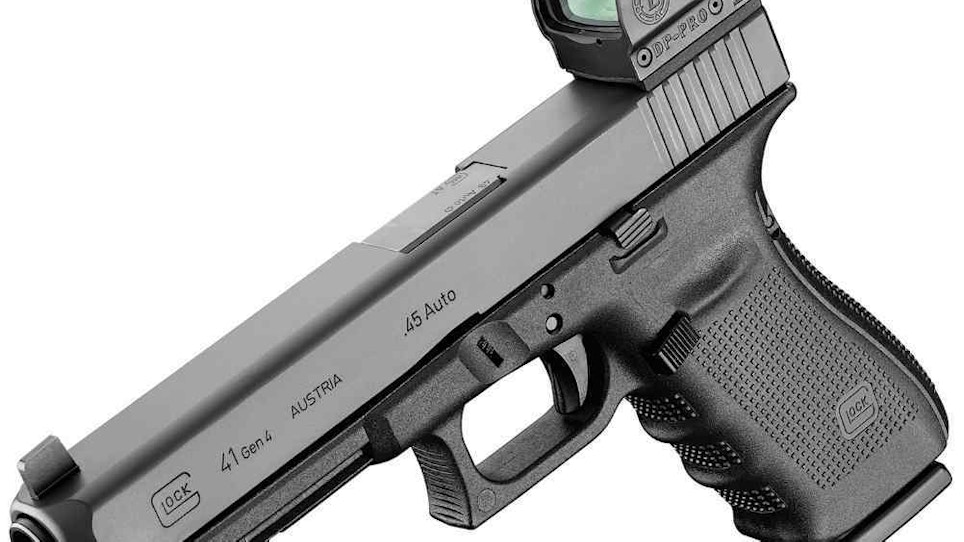Pistols fitted with optics aren’t anything new, but over the past few years they’ve become more popular than ever.
As a kid growing up in the early 1980s, there were a couple of revolvers such as the Colt Python Silhouette with mated telescopic sights for hunting purposes. They definitely caught the imagination, but were hardly mainstream.
Then, pistol-mounted optics took a different direction in the mid-1990s. Competition shooters began to mount red dot sights originally intended for use on long guns to their pistols. While very effective at aiding target acquisition thanks to their large objective windows, they were very large and required special mounts, making them impractical for recreational, let alone duty use.
In the late 90s, the move was made to create what we now know as the Miniature Red Dot Sight (MRDS). The MRDS projects an LED reticle onto a lens. Once the MRDS is properly aligned, it’s just like using any other optical sight. MRDS were intended as backup sights for larger telescopic sights and mounted either on top of or canted to the side of the scope for quick, close up shots or in case the primary optic stopped working.
Along with the advent of the MRDS came a new phenomenon: slide mounting. Due to its small size, an MRDS easily fits atop a pistol slide, taking the place of the rear sight. Initially, aftermarket accessory manufacturers solicited pistol owners to send their slides in to have them milled to except MRDS. Later, accessory manufacturers began offering off-the-shelf pistol slides for the most popular models that featured accommodations for mounting MRDS.
Unfortunately, because those sights were designed to sustain the recoil impulse of a rifle or shotgun, they were not intended for the repeated movement of a slide. While the long battery life of the LED was a big plus, for those who put high round counts on their pistols, MRDS were failing. It was then a simple matter of having those leaning forward in the foxhole using a product for something it wasn’t specifically designed for to provide vital feedback to the industry. Improvements came.
Leupold’s Delta Point Pro sight was developed with direct input from Special Operations Forces. They concentrated on LED brightness in daylight and durability under sustained firing. It also incorporated an adjustable rear sight for those instances when the sight stopped working. What was once looked at as a backup sight, now had its own back up sight. All of those things are now industry standard for pistol optics.
Perhaps the biggest piece of evidence that red dot-equipped pistols are the wave of the future is the U.S. military’s new modular handgun system. Although the U.S. Army didn’t ask for the ability to mount an optic to the pistol, MHS manufacturer Sig Sauer included the provision on the slide of the pistol. Currently, the cutout is covered with a plate, but once removed, it accepts an MRDS. That gives the U.S. military a great deal of flexibility for future upgrades to its pistol system.
The biggest challenge to more widespread adoption is the lack of an industry standard mounting solution. Optics manufacturers created their own mounting plates and pistol slide manufactures develop their own ways of attaching those plates. So far, the solution has been the use of various adapter plates to fit everything together.
My personal experience with a pistol mounted MRDS has been very positive. While I initially found myself hunting for the red dot, I soon learned through practice how to properly present the pistol so that my dot is in my vision and on target. For me, it felt like I had to lower the barrel of the pistol, but it became common practice very quickly.
Additionally, in my late 40s I went from wearing no glasses at all to bifocals. The red dot is much easier to focus on. Recently, I tried to fire a pistol equipped with standard sights and had a rough time moving my head around in order to take advantage of my glasses. With an MRDS, that is never an issue.
The most recent trend is to manufacture purpose-built MRDS optics specifically for use on a pistol. Take for example Aimpoint’s ACRO and Trijicon’s SRO. While they work fine on a rifle, they are a bit larger and more armored than the earlier optics used on pistols. That is to help them sustain the constant slamming of a pistol slide during firing, and prevent damage in the event of being dropped.
As in the case with the military’s new pistol, more and more models are coming from the factory already plumbed for use with MRDS. And it’s not just large frame pistols — subcompacts are getting the same treatment. Along with that trend, we are beginning to see new very low profile sights that are more suited to concealed carry.
Already, different sizes of optics as well different reticle sizes, colors and shapes are offered. Future trends will include ever increasing durability as well as mounting options. Hopefully, industry will eventually settle on a mounting standard. Regardless, pistol optics improve the way we shoot our pistols and increase access to firearms for those with vision issues.






